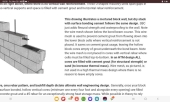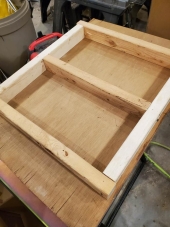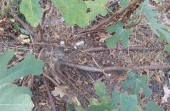This is my old post about the lime plaster. I have improved the text a little bit.
This is the mix that I use for compressed earth block, clay brick and concrete.
HOW TO MAKE LIME PUTTY
Ingredients for 20 l bucket:
-12 kg high calcium hydrated lime (make sure it's calcium lime not dolomitic Ca/Mg)
-10 l (more for additions) water
Tools:
-20 l bucket
-lid (if no lid is available then cover with plastic bag/film, then piece of plywood and secure with stone/brick)
-powerful drill with mixing paddle (I use Bosch hammer drill with SDS+ paddle)
Pour water into the bucket and add most of the lime and keep mixing till smooth. Occasionally you have to scrape the walls to reincorporate drier material into the mix that can not be reached by the paddle.
Keep adding the remaining lime and some more water. if needed The consistency should be very smooth, thicker than thick sour cream but a little thinner than cream cheese.
Smooth and level the top with the trowel, cover with 2 cm of water - all putty has to be covered - otherwise uncovered sections will dry.
It takes around 10 minutes to make one bucket of putty. Let it "age" for at least 2 days, so it will be more uniform.
HOW TO DETERMINE SAND TO PUTTY RATIO
Tools;
-sand
-isopropyl alcohol - at least 70 %, the less water the better so it will be less sticky
-measuring cup with 250 ml mark
Collect 250 ml of the sand you are going to use. It has to be completely dry. If not dry, then bake it in the oven. Fill the measuring cup with sand to 250 ml mark. Put it on a level surface. Start adding alcohol with a measuring spoons till the surface of sand is wet, but NOT more. Record the volume of alcohol added.
The volume of alcohol added to the volume of sand is your putty to sand ratio. For my sand it is 1:2.2.
HOW TO MAKE THE PLASTER MIX
To a wheelbarrow or mixing tray add sand and lime putty in the determined ratio Keep mixing. It will seem way too dry and you will be tempted to add a lot of water, but add only a little bit - a cup or few cups and keep mixing till smooth and uniform. Then you can add more water for desired consistency. At this moment you may add pozzolan (ash, pumice, ground bricks) and fibers. I add rice straw, cut to length no longer than 3 cm - 10% of sand volume used for the plaster.
Please remember to always smooth the top of remaining putty and cover with water and a lid.
One 20 l bucket of putty (12 kg of dry lime) is enough to plaster 5 m2 of wall (plaster thickness 10 mm).
Before plastering clean the wall, brush it, and whitewash with the putty+water mix (creamer consistency). It will create an interface for the plaster layer. It's important - especially when plastering adobe/cob.
When the whitewash solidifies after at least 24 hours, then spray with water and start plastering.
Protect the lime plaster from direct sun/high heat and temperatures lower than 5 C
Keep spraying the plaster with mist of water for a few days. In hot dry climates you may want to spray at least 3-4 times per day for 5 days. I recommend using large sprayer with a hose. The bottle sprayers are too small for larger jobs, have lower pressure and less capacity.
For larger jobs it helps tremendously to buy some used food grade barrel for mixing the putty. It took me 25 minutes to make putty from 70 kg of lime. If I did it in 20 l buckets I would spend over an hour.
I have not tried adding pozzolan yet. I have a pallet of extra fine pumice and I'm going to use it on exterior walls of my house.








